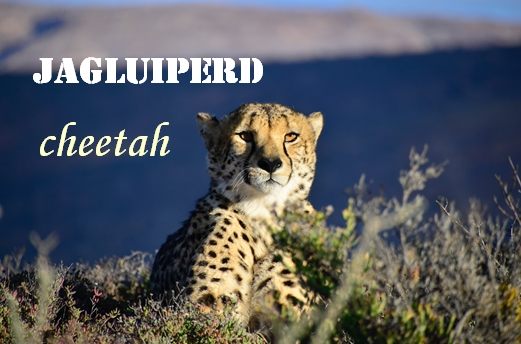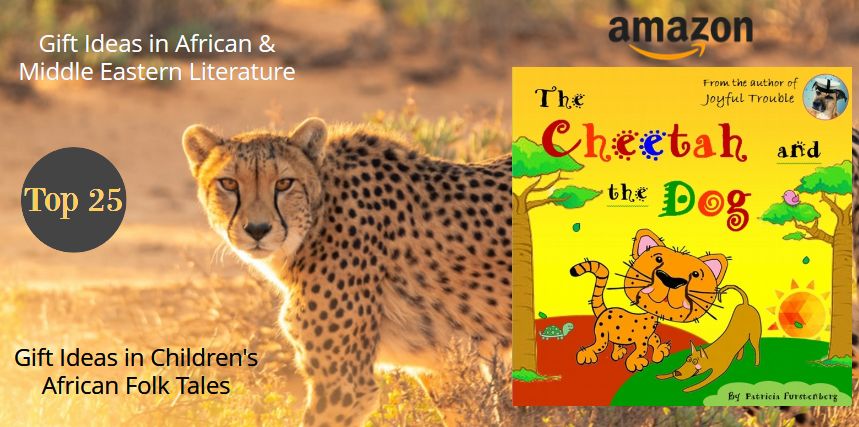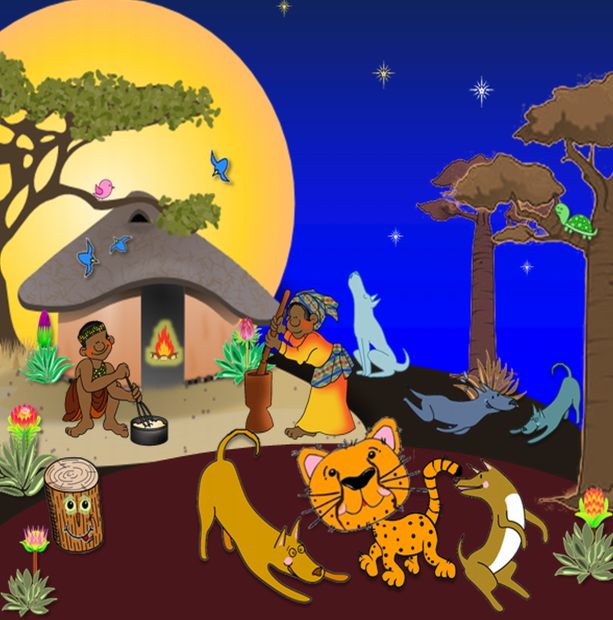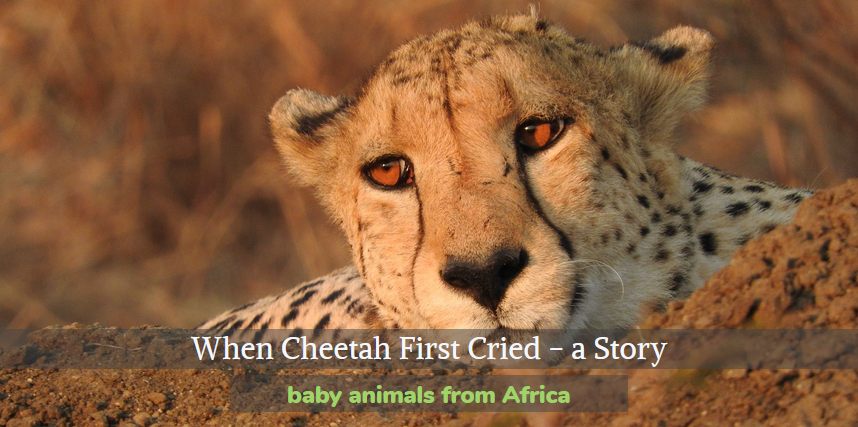When Cheetah First Cried is a retelling of an African folk story that explains why cheetahs have two vertical lines on their faces.
When Cheetah First Cried
Each day at dusk or dawn, when even the sun looked away and the wind only whispered, a cheetah left her nest hidden in the tall, dry grass to go hunt food for her cubs. She would give each one a gentle nudge, press her soft nose against their fluffy heads, take in their sweet scent, like any mother would, purr a quiet warning, then tiptoe across the grassland.
And each day at dusk and dawn, when the sun looked away for the cheetah went hunting, a man stooped by a tree and watched. He was a hunter too, from his own tribe.
The man watched with narrow eyes how cheetah lazily pranced across the field, how she seemed to stretch, careless, then lick her mouth at the sight of the Impala herd. How she lowered her head, watching the beautiful gazelles, choosing well and picking only the juicier one. ‘Hmph!’ the man-hunter often exclaimed, spitting in the sand at his feet, near a hunting bag filled with air. ‘Ever since our tribe was forced in this dry corner of grassland we’ve been beggars. And beggars can’t be choosers, like this wa chini.’ Then he pressed his fists in the small of his back and stretch, mimicking the cheetah. And just as the cheetah was now craning her neck, the man extended his and held his breath for he knew what came next.
The chase.
Impala and cheetah sprang at once. The gazelle, racing for its life, dashing, jumping, floating above the earth as if its life depended on it. The cheetah accelerating at an angle, its feet four times as strong, as fast; its tail swishing and swiping from behind, closing in and sprinting for victory.
‘Argh!’ exclaimed the man-hunter. The hunt never lasted much. The cheetah always won. There was always food to take home to her cubs. Unlike him. ‘Pshaw,’ he spat again, then picked up his empty bag and dragged it after him, almost crawling towards his village. But after two steps he stopped. He lifted his head and straightened his spine. No one saw his face, for none was around, but a bird. There was a snigger on it that pulled the corners of his thin, cracked lips upwards, in a non-human mask.
He knew what he had to do.
To allow for a steady supply of food for his village, of course.

The next day, when the cheetah went hunting, the man was waiting. Yet not by the tree, but hidden in the dry grass, not far from the cheetah’s nest. Yet far enough to be out of the wind’s way.
And after cheetah nudged her pups, sniffed their soft heads, and left in search of food, the man closed in, keeping as low as the grass. Without thinking twice he picked the three cheetah cubs and pushed them in his hunter’s bag, stuffing them inside, then closing the flap over, squeezing the bag to his chest to muffle their cries and running back to his village. Always bent over, always looking over his shoulder. Will the cheetah know? Will she hear her brood crying? Will she come after him? Is she at his heel already?
Goody, he’s made it!
That evening when cheetah returned with dinner for her cubs she found the nest empty. She sniffed around, the scent of her cubs still strong, yet no downy heads popped up to welcome her; no tiny, raspy tongues; no hungry yelps of joy, no tugs of war. And, like any mother, the cheetah cried. And she cried. And when the sun went up it found her crying, and when the moon came up it found her crying still.
Meanwhile, in the man’s village, the three cubs were tied to a pole for all to see the great plan of the man-hunter.
‘They will hunt for us,’ he would strut around, explaining his grand idea. ‘Three gazelles a day. There will be food aplenty,’ he would say, looking taller than anyone had ever seen him before.
The cheetah was still crying when a thin man approached her. He was so skinny and so old that he had no fear of being hunted, for he had no fear of death. Besides, he knew all too well that he looked like a wandering pile of sticks rather than a human being.
The skinny, old man approached the crying cheetah and asked what has happened. For nobody has ever seen a crying cheetah before, nor has anyone ever heard of one. On hearing what happened to her cubs the man made it for the village right away and the wind even stirred, they say, to give the old man a gentle push, to aid him reach the settlement sooner.
Three things happened next.
The man-hunter lost his right to hunt for having dishonored his people’s honest hunting tradition, that honored skill and respect for other hunters.
The man-hunter was sent to return the cubs to mother cheetah, while all the time crying and praying he won’t end up a prey himself. He didn’t, for the cheetah was too happy to be reunited with her cubs to even think of revenge.
The cheetah stopped crying, but having cried for so long two vertical dark lines remained along her face, from the inner corners of her eyes to the sides of her mouth.
This is the story of when the cheetah first cried and why the cheetah has two dark lines down her face.
© Patricia Furstenberg, 2001, All Rights Reserved.. Inspired by an old African legend

Why cheetahs need to live in the wild?
If a cheetah was born and raised in captivity, when released in the wild will hunt smaller giraffes, her hunting instinct having been altered. A cheetah growing in the wild will learn from her mother to hunt a bigger prey.
Yet not too big either.
At times, a cheetah born and raised in captivity, when released in the wild was observed trying to attack a buffalo. This is wrong and it will never be a success, as cheetah’s jaws and teeth are not designed to deal with such a large prey.
Discover the story of how the cheetah and the dog became friends:

Read inside also how were cheetahs built to live in the wild and why carnivore animals are seldom seen together?



Delightful!
Ah, thank you so much, Susan! 🙂
What a meaningful story. The wild animals know what to hunt, unlike us, humans, who kill just for sport sometimes. 🙁 I was afraid your story would wring my heart. Whew! What a relief that the cubs went back to mama-cheetah. 🙂 ❤️
Kind thanks, Jo. Your observation is spot on, again.
As a mom, I was happy about that little detail too. 😉
❤️
I loved this tale (pardon the pun). My guess is it a life lesson about morals and respect. Cheetahs are amazing animals too. 🙂
Thank you so much for telling me this, Mark 🙂
Oh, cheetahs are magnificent! Scary too 😉
What a beautiful story! I cried for the cheetah mom too.
Oh, thank you so much for letting me know! But I am really sorry to have caused you tears xx
She is a fighter, isn’t she 🙂
Sweet story.
Thank you so much, Martie 🙂 I value your input xx
In journals, I have a few short stories published. I know good writing when I read it.
Goodness, Martie, thank you 🙂 🙂 🙂
I loved reading this story! Just downloaded The Cheetah and the Dog.:-)
Goodness, Priscilla, thank you!
Well, it’s a kiddies story… I do hope it will make you smile.
Very moving to the soul and you always bring feelings and depth,peace
Thousand thanks!
I think you tell a story vividly enough that a read-aloud would intrigue even my little 3’s and 4’s! Great lesson as well. Putting it on my to-do list for purchase in the near future.
I am so happy to hear you enjoyed my story, Katy.
Kindly note that this short story is not included in ‘The Cheetah and the Dog’ book presented on this page.
I really enjoyed this lovely book, Patricia.
You are too kind, Roberta.
Thank you for your comment 🙂